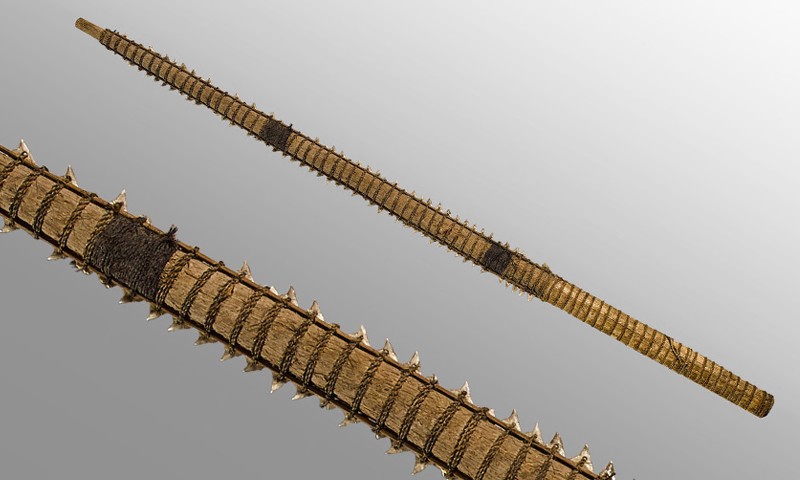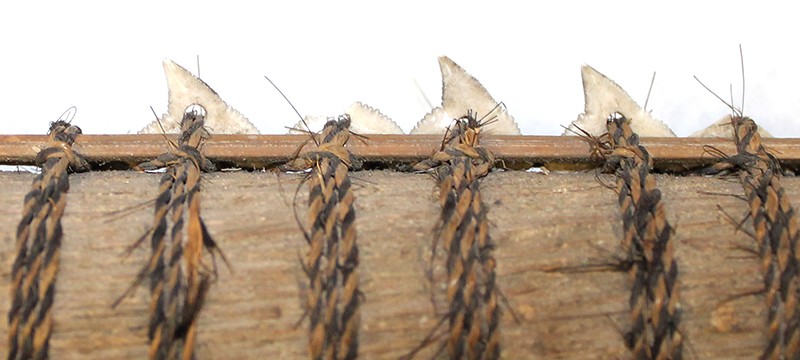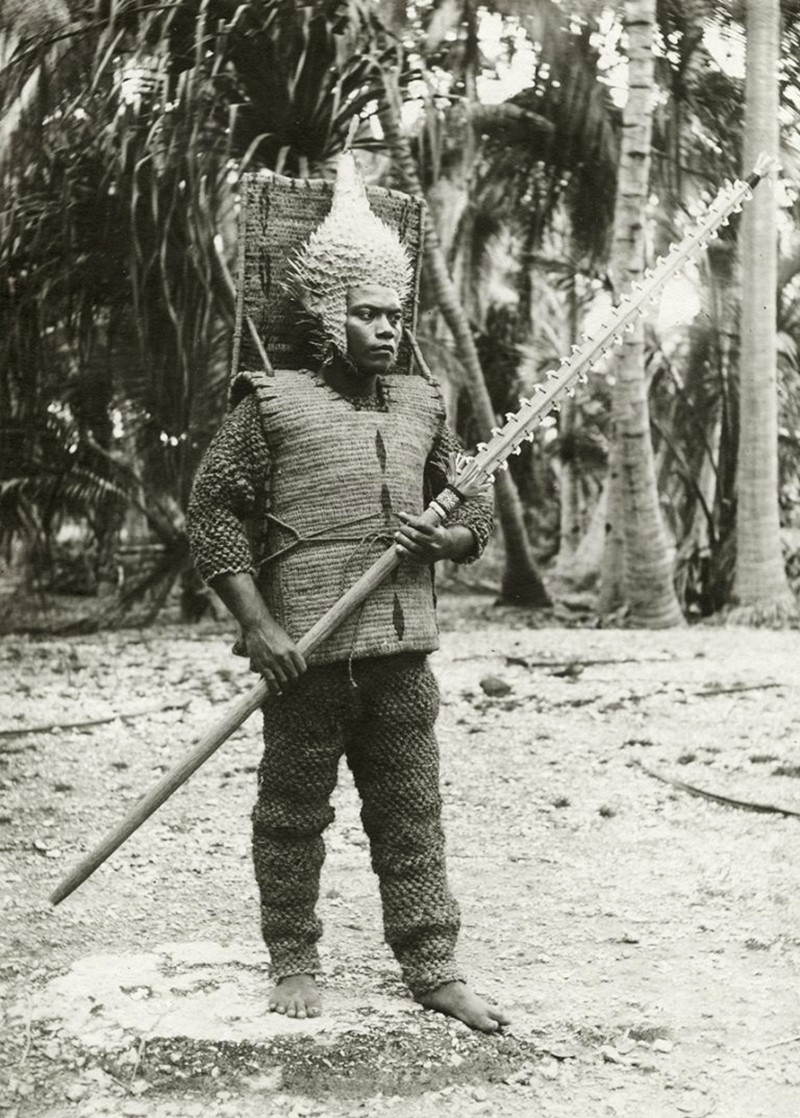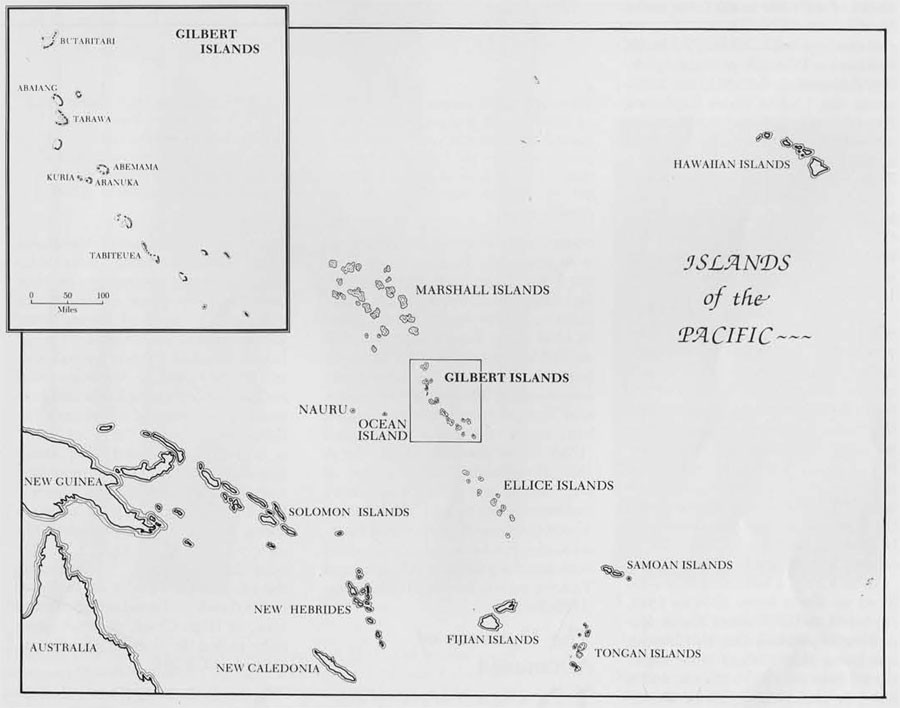 |
Club Sword (Te Toanea), mid 19th Century
I-Kiribati culture; Gilbert Islands, Republic of Kiribati, Micronesia
Wood, shark teeth, fiber, tapa and human hair; 34 1/2in.
2018.9.1
Gift of Mark Blackburn |
Whirling Dervish
Barring the outlandish Sharknado franchise, when we hear the phrase “shark attack,” the assumption is that we would have to be in the ocean to be in any real danger. This rule did not necessarily hold true to the Gilbert Islands in the modern-day Republic of Kiribati, Micronesia. Here the razor sharp, serrated teeth of sharks were attached to swords using a complex binding technique. The result was weapons, some of which could be up to 18 feet in length, which were lined with shark teeth. This post looks at one such new acquisition to the Bowers Museum, an approximately 3-foot-long shark tooth sword.
 |
| Detail of 2018.9.1 illustrating both the binding technique and the chipping resulting from usage. |
Tide and Tied
Based on a study of the Gilbert Islands’ weaponry, first published in 1923, thirteen different varieties of weapons were traditionally used on the islands. These ranged widely in length and function; but the Bowers’ new acquisition is a sword club referred to in the I-Kiribati vernacular as te toanea, te winnarei, or te tuangai. The wooden element of the club generally came from coconut wood sanded down to shape, but the major work of the sword went into acquiring and securing the teeth to the blade. Shark fishing was only done by experts. The larger size of the prey required fishermen to travel farther away from shore and employ methods including remarkable deep-sea hooks. When the teeth had been removed from the sharks, two methods were employed to secure them to swords. The first of these was a socketing technique. Small grooves were carved into the wood and the teeth were further stabilized with fiber cord. The technique used in the Bowers sword involves drilling small holes through the teeth themselves. Two thicker sections of palm fiber are then used to stabilize the teeth, and a more complex binding is used to ensure that the entire array of teeth is locked in place. This second method allows for the rare underlying layer of bark cloth we see in this example. The darker sections of fiber wrapping are human hair, used in almost every recorded example of Kiribati weaponry. The purpose of using hair was almost certainly magical—but little is definitively known about it.

 |
I-Kiribati man in full armor, c. 1915
Photo: George Hubert Eastman, © Museum of Archaeology and Anthropology, University of Cambridge |
Toothé
War in Kiribati’s islands took place for any of the usual reasons. As sides faced off, combat usually began with projectiles—mostly stones, but in this case shark-barbed spears were also used. The next phase involved using the incredibly long spears to pierce armor and weaken one’s enemy. When the distance between the two war parties had been closed, the shark tooth sword clubs were used. These swords were not only threatening in appearance but were extremely effective at inflicting both shallow lacerations and blunt force trauma. Ceremonial duels between the champions of feuding villages were often settled using te toanea as well. Combat on the Gilbert Islands tended to inflict many injuries, but relatively few fatalities. One of the reasons for this is the immensely effective armor used by I-Kiribati warriors. This included a visually impressive pufferfish helmet, but the real strength of the armor was a woven coir suit which covered the entire body. A second double-thick layer woven from sturdier materials protected the chest, neck and head from club blows.

 |
| Map of the Gilbert Islands |
Shark-Weak
Shark teeth were hardy enough against skin and fiber, but anything tougher could shatter them. Warriors returning home to replace broken teeth was an unglamorous epilogue to almost every combat. The shortcomings of the medium indicate that its true importance was psychological and magical. As with many Micronesian and Polynesian cultures, sharks played an important cultural role for the I-Kiribati: sharks are involved in the origin mythology of the islands and they played a major part in cult initiation ceremonies. Using part of the great creatures in a weapon would imbue it with some of the shark’s strength. We can see too that sharks have continued to play an important role in Kiribati. By identifying teeth used in Gilbert Islands weaponry, researchers from Columbia University and the Field Museum were able to prove that at least two of the sharks once used for these weapons were no longer endemic to the region. Not three years later Kiribati created the world’s second largest shark sanctuary.
Text and images may be under copyright. Please contact Collection Department for permission to use. References are available on request. Information subject to change upon further research.






Comments 1
What is the value of the sword style if it is in very good shape.